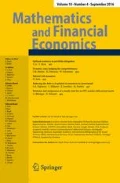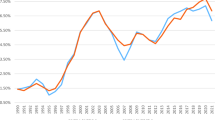Abstract
This paper deals with a model for pricing Collateralized Loan Obligations, where the underlying credit risk is driven by a marked Hawkes process, involving both clustering effects on defaults and random recovery rates. We provide a sensitivity analysis of the CLO price with respect to the parameters of the Hawkes process using a change of probability and a variational approach. We also provide a simplified version of the model where the intensity of the Hawkes process is taken as the instantaneous default rate. In this setting, we give a moment-based formula for the expected survival probability.


Similar content being viewed by others
References
Hawkes, A.G.: Point spectra of some mutually exciting point processes. J. R. Stat. Soc. 33, 438–443 (1971)
Hawkes, A.G., Oakes, D.: A cluster process representation of a self-exciting point process. J. Appl. Probab. 11(3), 495–503 (1974)
Filimonov, V., Sornette, D.: Apparent criticality and calibration issues in the hawkes self-excited point process model: application to high-frequency financial data. Quant. Finance 15(8), 1293–1314 (2015)
Ait-Sahalia, Y., Yu, J.: High frequency market microstructure noise estimates and liquidity measures. Ann. Appl. Stat. 3(1), 422–457 (2009). 03
Donatien, H.: A model for interest rates with clustering effects. Quant. Finance 16(8), 1203–1218 (2016)
Jiao, Y., Ma, C., Scotti, S.: Alpha-CIR model with branching processes in sovereign interest rate modelling. Finance Stochast. 21(3), 789–813 (2017)
Jiao, Y., Ma, C., Scotti, S., Sgarra, C.: A branching process approach to power markets. Energy Economics (2018). https://doi.org/10.1016/j.eneco.2018.03.002
Filimonov, V., Bicchetti, D., Maystre, N., Sornette, D.: Quantification of the high level of endogeneity and of structural regime shifts in commodity markets. J. Int. Money Finance 42, 174–192 (2014)
Bacry, E., Muzy, J.F.: Hawkes model for price and trades high-frequency dynamics. Quant. Finance 14(7), 1147–1166 (2014)
Peng, X.H., Kou, S.: Connecting the top-down to the bottom-up: Pricing cdo under a conditional survival (cs) model. In: Proceedings of the 40th Conference on Winter Simulation. Winter Simulation Conference, pp. 578–586 (2008)
Errais, E., Giesecke, K., Goldberg, L.R.: Affine point processes and portfolio credit risk. SIAM J. Financ. Math. 1(1), 642–665 (2010)
Ding, X., Giesecke, K., Goldberg, L.: A top down approach to multi name credit. Oper. Res. 59(2), 283–300 (2011)
Bernis, G.: Mark-to-model for cash CDOs through indifference pricing. Quant. Finance 12(1), 39–48 (2012)
Laurent, J.P., Gregory, J.: Basket default swaps, cdos and factor copulas. J. Risk 7(4), 103–122 (2003)
Sirignano, J.A., Tsoukalas, G., Giesecke, K.: Large-scale loan portfolio selection. Oper. Res. 64(6), 1239–1255 (2016)
Sirignano, J.A., Giesecke, K.: Risk analysis for large pools of loans. Manag. Sci. (forthcoming) (2017)
Chang, Y.P., Hung, M.C., Liu, C.C.: Analytical approximation method of collateralized debt obligation pricing in one-factor models. In: 2007 International Conference on Convergence Information Technology (ICCIT 2007), pp. 677–680 (2007)
Fournié, E., Lasry, J.M., Lebuchoux, J., Lions, P.L., Touzi, N.: Applications of malliavin calculus to monte carlo methods in finance. Finance Stochast. 3, 391–412 (1999)
Giesecke, K., Zhu, S.: Transform analysis for point processes and applications in credit risk. Math. Finance 23(4), 742–762 (2013)
Last, G., Brandt, A.: Marked Point Processes on the Real Line the Dynamic Approach. Springer, New York (1995)
Dellacherie, C., Meyer, P.A.: Probabilités et Potentiels. chapitre I à IV. Hermann, Paris (1978)
Brémaud, P., Massoulié, L.: Imbedded construction of stationary sequences and point processes with a random memory. Queueing Syst. 17, 213–234 (1994)
Ogata, Y.: The asymptotic behaviour of maximum likelihood estimators for stationary processes. Ann. Inst. Stat. Math. 30, 243–261 (1978)
Callegaro, G., Gaïgi, M., Scotti, S., Sgarra, C.: Optimal investment in markets with over and under-reaction to information. Math. Financ. Econ. 11(3), 299–322 (2017)
Bacry, E., Mastromatteo, I., Muzy, J.F.: Hawkes processes in finance. Mark. Microstruct. Liq. 1(01), 1550005 (2015)
Protter, Ph: Stochastic Integration and Differential Equations. Springer, New York (1992)
Heath, D., Jarrow, R., Morton, A.: Bond pricing and the term structure of interest rates a new methodology. Econometrica 60(1), 77–105 (1992)
Acknowledgements
The opinions and views expressed in this document are those of the authors and do not necessarily reflect those of Natixis Asset Management. The authors wish to thank Nicolas Bouleau for fruitful discussions on the sensitivity analysis for Poisson processes. The research of the third author is supported by Institut Europlace de Finance within the project “Clusters and Information Flow: Modeling, Analysis and Implications”.
Author information
Authors and Affiliations
Corresponding author
Appendices
Appendices
1.1 Proof of Proposition 2
Proof
Let \(\delta \in ]0, \overline{\delta }]\). The first step consists in a Taylor expansion of second order (in \(\delta \)) of \(g(\delta ) := L[\lambda +\delta h](T_n)\). We have
With these notations, we omit the dependency in \(T_1, \dots , T_n\), that will be made clear in the next equations. Straightforward calculation yields
Now, we can turn to the uniform integrability of the second order derivative for \(\delta \in [0, \overline{\delta }]\). For this purpose, we notice that \(\lambda (\cdot ) + \delta h(\cdot )\) is an element of \({\mathcal {D}}(m^{'},a^{'}, b^{'})\), with \(m^{'} := \lambda _0\), \(a^{'}:=\lambda _0+a\) and \(b^{'}:=\overline{\alpha } + b \overline{\delta }\). We are now in position to provide boundaries for g, \(\dot{g}\) and, eventually, \(\ddot{g}\). We obtain successively
Now, we need to check that elements of the form \(T_n^2e^{-(\lambda _0-1) T_n}\) are \(\mathbb {P}\)-integrable. The law of \(T_n\) under \(\mathbb {P}\) is a Gamma law \(\Gamma (n,1)\), thus
where we have used the formula of the second order moment of a Gamma law. With these elements in hand, we can state that there exists a constant C, depending only on n, \(m^{'}\), \(a^{'}\), \(b^{'}\) and \(\lambda _0\), such that
Since f is uniformly bounded, this implies that the directional derivative of \(I[\lambda ](f)\) (on the right) in the direction h exists and is given by (6) with
We factorize \(L[\lambda ](T_n)\) in (17), which yields the exact form of \(G(T_n)\) if we notice that \(\sum _{k=1}^n\frac{h(T_k)}{\lambda (T_k)} = \int _0^{T_n}\frac{h(s)}{\lambda (s)}\nu (ds)\). \(\square \)
1.2 Proof of Lemma 3
We shall prove the result by recurrence on n. The case \(n=1\) is given by Corollary 3. Assume that the property holds for any \(1\le k\le n-1\). Now, set, for any \(t \ge 0\),
By recurrence, we know that the limit of \(\Upsilon _n(t)\), when t tends to \(+\infty \) exists. Let us denote it by \(\overline{\Upsilon }_n\). By Lemma 2, we can step \(m_n(t) = g(t)e^{n(\alpha -\beta )t}\) obtaining \(\dot{g}(t) = \Upsilon _n(t) e^{-n(\alpha -\beta )t}\). By the recurrence property, we have
Then, by L’Hôpital’s rule, we have
Hence, we have the equivalence (15) and \(\overline{m}_n:= \frac{\overline{\Upsilon }_n}{n(\beta -\alpha )}\).
Now, let us prove that \(m_n\) is increasing. For this purpose, note
By recurrence assumption, \(\Upsilon _n\) is increasing as a sum of increasing functions (all the coefficients are positive). Then
Hence, we have \(\frac{\dot{g}(t)}{g(t)} > n(\beta -\alpha )\) if, and only if, \(\Upsilon _n(t) > n(\beta -\alpha ) \lambda ^n_0\). As \(\Upsilon _n\) is increasing, it is sufficient to show that the condition holds for \(t=0\). In this case, we easily see that \(\Upsilon _n(0)> n\beta \lambda _0^n> n(\beta -\alpha ) \lambda _0^n\). Hence, \(\frac{\dot{g}(t)}{g(t)} > n(\beta -\alpha )\), which implies that \(m_n(t)\) is increasing. \(\Box \)
1.3 Proof of Proposition 4
According to Lemma 5, we only need to prove that the limit of \(u_n:=\frac{m_n(t)}{n!}\) is 0, when n goes to \(\infty \). First, let us rewrite \(u_n\) with Eq. (13). It yields
Set \(\delta >0\), such that \(\frac{\alpha ^2}{2(\beta - \alpha )} (1 + \delta +\frac{\alpha }{3}e^{\alpha } ) < 1\). There exists \(n_0\), such that, for any \(n \ge n_0\),
Let us define \(K_p:=\max \left\{ u_k \; \vert \; 1\le k\le p \right\} \), for any \(p \ge 1\). For \(n \ge n_0\), we have
where we have used the Taylor development of the exponential function at order 2. From Eq. (18), we deduce that \(K_n = K_{n-1}\). Therefore, the sequence \((K_p)_{p\ge n-1}\) is constant, equal to \(K>0\). Set
By Eq. (18), we have, for any \(n\ge n_0\),
Set \(n\ge n_0+p\), with p such that \(\frac{K}{\beta -\alpha } \sum _{k=p+1}^{\infty }\frac{\alpha ^k}{k!} \le \frac{K\overline{H}_{\delta }^2}{n_0}\). Using again the Taylor expansion of the exponential and the inequality above, we have the following inequality, for any \(n \ge n_0+p\),
Set \(n_1:=n_0+p\). By iteration of this method, we can construct an increasing sequence of integer \((n_k)_{k\ge 1}\) such that, for any \(i \ge n_k\),
The limit of the right hand side is 0, which yields the result. \(\square \)
Rights and permissions
About this article
Cite this article
Bernis, G., Salhi, K. & Scotti, S. Sensitivity analysis for marked Hawkes processes: application to CLO pricing. Math Finan Econ 12, 541–559 (2018). https://doi.org/10.1007/s11579-018-0215-6
Received:
Accepted:
Published:
Issue Date:
DOI: https://doi.org/10.1007/s11579-018-0215-6
Keywords
- Change of probability
- Credit derivatives
- Poisson processes
- Hawkes processes
- Self-exciting structure
- Sensitivity analysis




